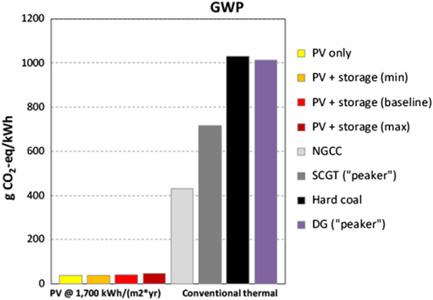当前位置:
X-MOL 学术
›
Energy Technol.
›
论文详情
Our official English website, www.x-mol.net, welcomes your feedback! (Note: you will need to create a separate account there.)
What Are the Energy and Environmental Impacts of Adding Battery Storage to Photovoltaics? A Generalized Life Cycle Assessment
Energy Technology ( IF 3.8 ) Pub Date : 2020-01-17 , DOI: 10.1002/ente.201901146 Marco Raugei 1, 2 , Enrica Leccisi 2 , Vasilis M. Fthenakis 2
Energy Technology ( IF 3.8 ) Pub Date : 2020-01-17 , DOI: 10.1002/ente.201901146 Marco Raugei 1, 2 , Enrica Leccisi 2 , Vasilis M. Fthenakis 2
Affiliation

|
Renewable electricity generation is intermittent and its large‐scale deployment requires some degree of energy storage. Although best assessed at grid level, the incremental energy and environmental impacts of adding the required energy storage capacity may also be calculated specifically for each individual technology. This article deals with the latter issue for the case of photovoltaics (PV) complemented by lithium‐ion battery (LIB) storage. A life cycle assessment (LCA) of a 100 MW ground‐mounted PV system with 60 MW of lithium‐manganese oxide (LMO) LIB, under a range of irradiation and storage scenarios, shows that energy payback time and life cycle global warming potential increase by 7–30% (depending on storage duration scenarios), with respect to those of PV without storage. Thus, the benefits of PV when displacing conventional thermal electricity (in terms of carbon emissions and energy renewability) are only marginally affected by the addition of energy storage.
中文翻译:

在光伏电池中增加电池储能对能源和环境有何影响?广义生命周期评估
可再生能源发电是间歇性的,其大规模部署需要一定程度的能量存储。尽管最好在电网级别进行评估,但是也可以针对每种单独的技术专门计算增加所需储能容量所带来的增量能源和环境影响。本文针对光伏(PV)辅以锂离子电池(LIB)储存的情况解决后一个问题。在一系列辐照和存储场景下,具有60 MW锂锰氧化物(LMO)LIB的100 MW地面光伏系统的生命周期评估(LCA)显示,能源回收时间和生命周期的全球变暖潜力增加相对于不带存储的PV,降低了7–30%(取决于存储时间方案)。从而,
更新日期:2020-01-17
中文翻译:

在光伏电池中增加电池储能对能源和环境有何影响?广义生命周期评估
可再生能源发电是间歇性的,其大规模部署需要一定程度的能量存储。尽管最好在电网级别进行评估,但是也可以针对每种单独的技术专门计算增加所需储能容量所带来的增量能源和环境影响。本文针对光伏(PV)辅以锂离子电池(LIB)储存的情况解决后一个问题。在一系列辐照和存储场景下,具有60 MW锂锰氧化物(LMO)LIB的100 MW地面光伏系统的生命周期评估(LCA)显示,能源回收时间和生命周期的全球变暖潜力增加相对于不带存储的PV,降低了7–30%(取决于存储时间方案)。从而,



























 京公网安备 11010802027423号
京公网安备 11010802027423号